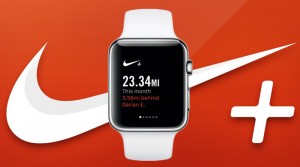In my last blog post, I talked about the benefits of exercise and some new research being conducted in that area. In this post, I will look at personal fitness trackers and wearables. It is easier than ever for any individual to improve their own well-being and health with all these technological tools. Fitness trackers are significant because they can motivate people to exercise, which can be life changing for many people. This technology can put exercise in a whole new light, changing the perception of exercise from just a necessity to something that people actually enjoy.
Fitness trackers and wearables such as a Fitbit and Apple Watch and apps like Nike+ Run Club and RunKeeper can be the solution to America’s inactivity problem. They make it easier to measure various aspects of your health and fitness and can be an incentive to exercise more often. Fitness trackers make it easier to measure a one’s miles, heart rate, quality of sleep, etc. Sensors built into wearable devices and mobile devices can track movement, speed, acceleration and change in elevation.
These wearables come with many benefits. They promote being active. For example, the Apple Watch tells you to stand up if you have been sitting for too long. Also these fitness trackers can gamify exercise. They make exercise into a game experience or social activity, where you compete and share with friends. Exercise can become something to look forward to and be excited about. It also can become a way of life and not something that is dreaded.
Apps like Nike+ Run, Club and RunKeeper provide tangible evidence of your exercise routine, keeping track of how many workouts and miles you have completed, and allowing you to track your improvement over time. They also provide detailed training plans to help you reach your goal of running a certain distance, whether it is a 5K or a marathon. Since individuals are wearing these devices at all times, there is an enormous amount of useful data, both for individuals and researchers.
On the iPhone and through the Apple Watch there is a Health app, which aggregates health and fitness information from multiple sources. Patients are already beginning to share their health data with doctors and insurance companies to demonstrate how healthy they are, save money, and earn rewards. ResearchKit makes it easier to collect reliable data for medical research on a large scale, by leveraging billions of Apple devices. It is being used to conduct research on Parkinson’s disease, diabetes, breast cancer, and cardiovascular disease.

The Halo Sport in action.
Another really fascinating wearable is the Halo Sport, a product by Halo Neuroscience. It looks like Beats headphones, with electrodes that stimulate the motor cortex in the brain (known as neuropriming) to allow for quicker acquisition of skills and building muscle strength. The motor cortex sends stronger signals to the muscles, which activates more muscle fibers and allows athletes to get more from each rep. It is currently being used by athletes while training on Major League Baseball teams, as well as the US Olympic Ski and Snowboarding teams, to try and develop players faster, and will soon be available to the public. The Department of Defense even uses it to train special operations forces. It is also being implemented to help those who have suffered from a stroke to recover faster. There are hopes of eventually creating products that stimulate other areas of brain besides the motor cortex, such as those related to memory and thinking.
Fitness trackers have become valuable devices for both fitness and health research. With increased popularity, they should continue to make valuable contributions to the lives of millions of people and make the world a more healthy and active place.
Picture Source:
- Nike apple watch nikeapp.jpg


I love my Fitbit and I do not leave the house without it. I tried out a couple other brands of fitness trackers before getting a Fitbit and I like it the best. I really do believe that it has benefited my health in multiple ways. At my summer job, I sit at my desk for the majority of the day, and once an hour my Fitbit would vibrate telling me it’s time to get up and stretch. It helped me be more dynamic during my workday, and sometimes I am so motivated to reach my step goal, I will go on an unplanned run just to feel the satisfaction of having a successful day. I think more people should get Fitbits or other activity trackers so they can become aware of how active they are in their daily life. Awesome post!
As an avid Fitbit wearing I personally connected to your blog post. The ability to track my fitness along with connect with friends through a social-media platform that they have set up creates a competitive game-like atmosphere that motivates me to do more. It is human nature to be competitive, and these fitness products are perfectly exploiting it. It is one thing to track your own fitness, but to have the ability to challenge your friends to a step challenge creates this competitive drive that leads people to walk a little bit more everyday or take the stairs instead of the elevator. However this technology does have a down-side as described in this article written by personal trainer Johnny Adamic. He describes the fitness tracker phenomenon is causing people to rely on an app to tell them about their bodies rather than actually listening to the cues from our bodies. While I think this technology is great, we all need to be aware that the competition is not everything and at the end of the day no step goal is worth putting yourself in harms way. You can read more about Johnny’s pro and con argument on fitness trackers at this website http://www.thedailybeast.com/articles/2015/04/05/the-dark-side-of-your-fitbit-and-fitness-app.html .